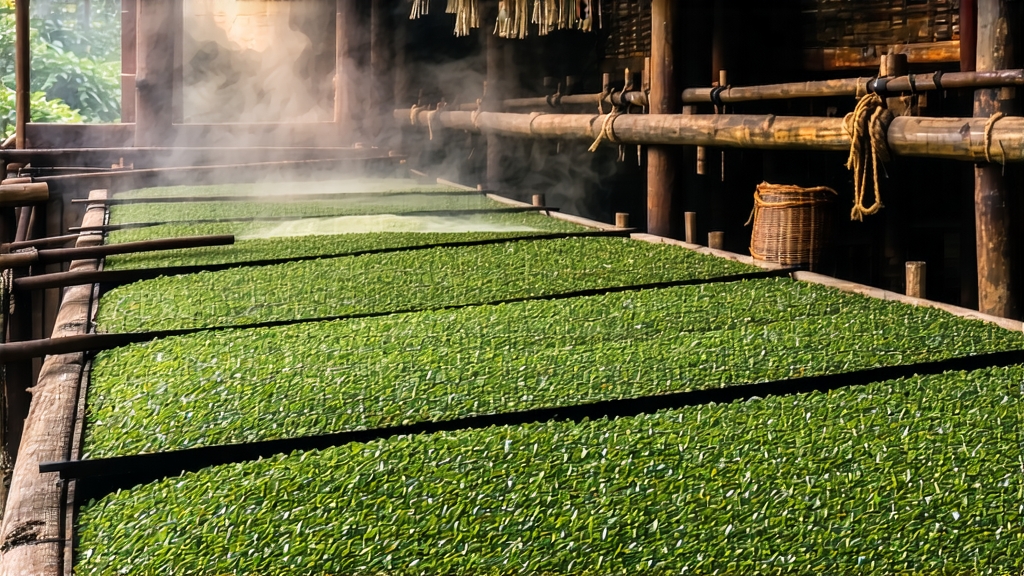
Long before English breakfast blends and Assam malts filled porcelain cups, a small village in the Wuyi massif of northern Fujian produced the very first black tea the world ever tasted. Locals call it Zheng Shan Xiao Zhong; foreigners, remembering the old Cantonese port name, still ask for “Lapsang Souchong.” Whatever the label, the tea carries within its curled, pitch-black leaves the dual signature of China’s inventiveness and its forests: the sweet resinous perfume of Masson pine and the warm, longan-like sweetness of meticulously withered tea. To understand Chinese black tea—what the Chinese themselves call hong cha, “red tea”—one must begin here, in the cradle of the genre, where smoke once signaled the birth of a global beverage.
History: From Mountain Refuge to Global Sensation
The story begins around 1640, in the closing decades of the Ming dynasty. Wuyi’s monasteries had for centuries produced compressed “dragon” tea cakes for the imperial court, but when the court suddenly banned these cakes in favor of loose-leaf, monks and farmers needed a new style that could travel safely to the bustling port of Xiamen. A happy accident—some say a passing army requisitioned fresh leaf for bedding—forced villagers to speed-dry their harvest over open pine fires. The resulting tea, copper-red in the cup and hauntingly aromatic, reached Dutch traders who ferried it to Europe as “bohea,” a corruption of “Wuyi.” By the late 1600s Lapsang Souchong was selling in Amsterdam for ten times the price of green tea, and within fifty years London coffeehouses were advertising “souchong” as the fashionable gentleman’s drink. Thus the world’s first black tea also became its first Chinese tea craze, predating Keemun by two centuries and inspiring the British to plant tea gardens half a planet away in India and Ceylon.
Terroir: Why Wuyi’s Mist Matters
Authentic Zheng Shan Xiao Zhong can legally be produced only within the 600 km² core of the Wuyi National Nature Reserve, where granitic peaks trap humid maritime air, creating a perpetual swirl of fog that filters sunlight into a soft, diffused glow. Day-night temperature swings of 15 °C slow the growth of the small-leaf Da Bai varietal, concentrating amino acids and sugars. The forest floor, thick with pine needles and fern humus, perfumes the soil; even the spring water used for withering carries a faint resin note. Move the same bushes fifty kilometers downhill and the tea loses its signature pine-smoke affinity, proving that Lapsang Souchong is less a recipe than a dialogue between plant and place.
Two Styles: Smoke and No Smoke
International consumers usually picture a tarry, campfire brew, yet within China the tea is drunk primarily in its unsmoked form, called Wu Yan Xiao Zhong. Both versions begin identically: one bud and two leaves plucked before Qingming festival, when overnight temperatures still dip below 10 °C. The difference occurs during the final drying. For traditional Lapsang, craftsmen lay the oxidized leaf on bamboo trays suspended over a pinewood pit fire; the smoke rises gently for eight hours, curling around amino acids to create guaiacol and syringol, the molecules responsible for the whisky-like aroma. In the modern Wu Yan process, hot-air ovens replace the pine fire, allowing the natural honey, longan and mineral notes to dominate. Neither is superior; they are yin and yang expressions of the same leaf.
Craftsmanship: Eight Steps, One Mistake, No Second Chance
- Plucking: Only the village’s indigenous small-bush ecotype, never high-yield clonal hybrids, may enter the workshop.
- Solar withering: Leaf is spread on bamboo mats in direct morning sun for 20 minutes to soften cell walls.
- Indoor withering: Moved onto slatted shelves, it rests 4–6 hours while mountain breeze reduces moisture to 60 %.
- Rolling: A 45-minute gentle roll on cast-iron trays bruises edges without breaking stems, initiating oxidation.
- Enzymatic oxidation: Leaf is piled in pine-wood crates covered with wet cloth; temperature held at 24 °C for 3 hours until 90 % of catechins convert to theaflavins.
- Smoking or baking: The